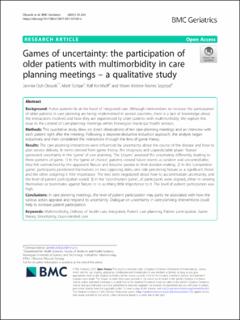| dc.contributor.author | Oksavik, Jannike Dyb | |
| dc.contributor.author | Solbjør, Marit | |
| dc.contributor.author | Kirchhoff, Ralf | |
| dc.contributor.author | Sogstad, Maren Kristine Raknes | |
| dc.date.accessioned | 2022-09-20T06:55:02Z | |
| dc.date.available | 2022-09-20T06:55:02Z | |
| dc.date.created | 2021-04-14T09:42:14Z | |
| dc.date.issued | 2021 | |
| dc.identifier.citation | BMC Geriatrics. 2021, 21 . | en_US |
| dc.identifier.issn | 1471-2318 | |
| dc.identifier.uri | https://hdl.handle.net/11250/3019010 | |
| dc.description.abstract | Background
Active patients lie at the heart of integrated care. Although interventions to increase the participation of older patients in care planning are being implemented in several countries, there is a lack of knowledge about the interactions involved and how they are experienced by older patients with multimorbidity. We explore this issue in the context of care-planning meetings within Norwegian municipal health services.
Methods
This qualitative study drew on direct observations of ten care-planning meetings and an interview with each patient right after the meeting. Following a stepwise-deductive induction approach, the analysis began inductively and then considered the interactions through the lens of game theory.
Results
The care-planning interactions were influenced by uncertainty about the course of the disease and how to plan service delivery. In terms derived from game theory, the imaginary and unpredictable player ‘Nature’ generated uncertainty in the ‘game’ of care planning. The ‘players’ assessed this uncertainty differently, leading to three patterns of game. 1) In the ‘game of chance’, patients viewed future events as random and uncontrollable; they felt outmatched by the opponent Nature and became passive in their decision-making. 2) In the ‘competitive game’, participants positioned themselves on two opposing sides, one side perceiving Nature as a significant threat and the other assigning it little importance. The two sides negotiated about how to accommodate uncertainty, and the level of patient participation varied. 3) In the ‘coordination game’, all participants were aligned, either in viewing themselves as teammates against Nature or in ascribing little importance to it. The level of patient participation was high.
Conclusions
In care planning meetings, the level of patient participation may partly be associated with how the various actors appraise and respond to uncertainty. Dialogue on uncertainty in care-planning interventions could help to increase patient participation. | en_US |
| dc.language.iso | eng | en_US |
| dc.publisher | BMC | en_US |
| dc.rights | Navngivelse 4.0 Internasjonal | * |
| dc.rights.uri | http://creativecommons.org/licenses/by/4.0/deed.no | * |
| dc.title | Games of uncertainty: the participation of older patients with multimorbidity in care planning meetings - a qualitative study | en_US |
| dc.title.alternative | Games of uncertainty: the participation of older patients with multimorbidity in care planning meetings - a qualitative study | en_US |
| dc.type | Peer reviewed | en_US |
| dc.type | Journal article | en_US |
| dc.description.version | publishedVersion | en_US |
| dc.source.pagenumber | 11 | en_US |
| dc.source.volume | 21 | en_US |
| dc.source.journal | BMC Geriatrics | en_US |
| dc.identifier.doi | 10.1186/s12877-021-02184-z | |
| dc.identifier.cristin | 1903924 | |
| cristin.ispublished | true | |
| cristin.fulltext | original | |
| cristin.qualitycode | 1 | |

